It’s BILL FINGER’s birthday: Here’s an accidental discovery that changes what you know about DC and Marvel history.

—
UPDATED 2/8/20: Bill Finger was born Feb. 8, 1914 — 106 years ago. Perfect time to re-present this piece from 2017. For more stories celebrating Finger, check out the links below. — Dan
—
I started a summer project recently — reading every Batman and Detective in order, starting with 1964’s “New Look.”
For you whippersnappers out there, the “New Look” was a Batman revamp orchestrated by legendary editor Julius Schwartz: Out was the house art style, which had grown woefully stale, and in was a jazzier, more “realistic” artistic approach most notably cultivated by Carmine Infantino. (Such things are relative, of course. Neal Adams completely blew the lid off realistic comics art a few years later.)
The changeover happened in Detective Comics #327 and Batman #164: The bulky, bubble-topped Batmobile was mothballed and replaced by a sleek convertible; a “hot-line” with Commissioner Gordon was installed in the Batcave; Bruce and Dick used an elevator to reach the Batcave instead of the long staircase; and Batman’s own chest emblem was now encircled in yellow.
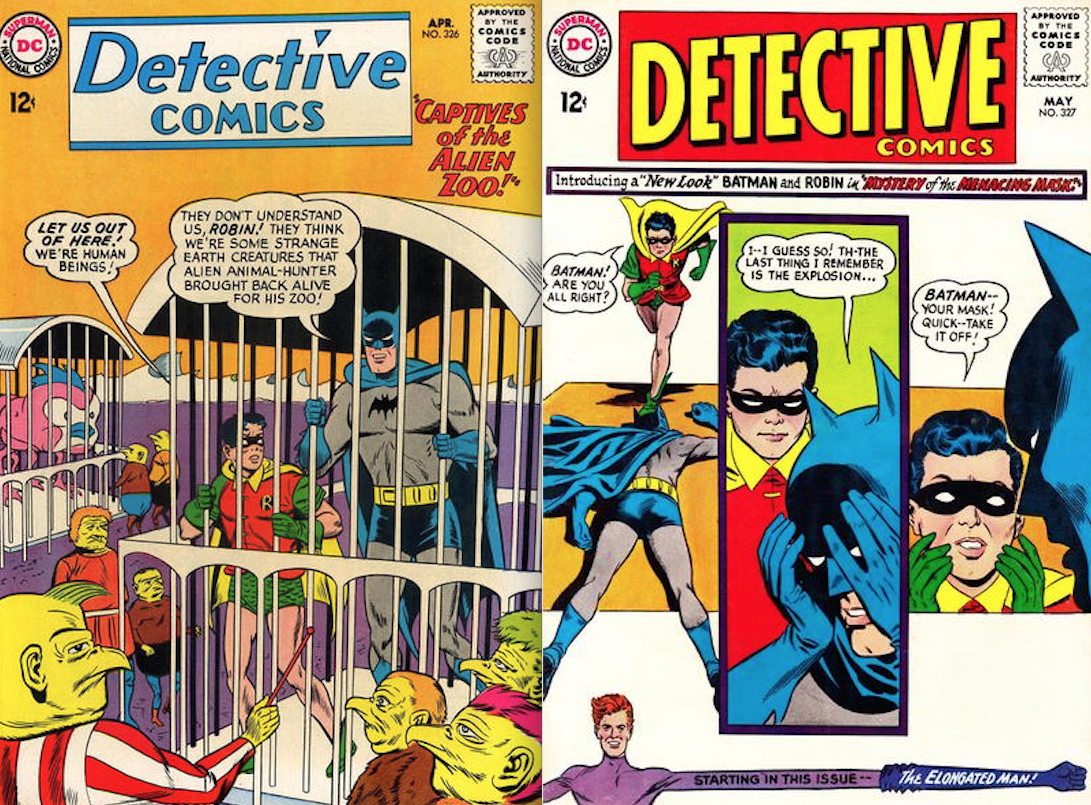
Last “old look” Detective; first “New Look” Detective
Most importantly, though, Schwartz and writers like Batman co-creator Bill Finger, Gardner Fox, John Broome and France “Eddie” Herron dumped the silly aliens and monsters that were plaguing the titles, in favor of a return to gangsters and detective work. Sure, there were the still-welcome costumed villains and high-concept gadgetry, but Batman was now earthbound, metaphorically and literally.
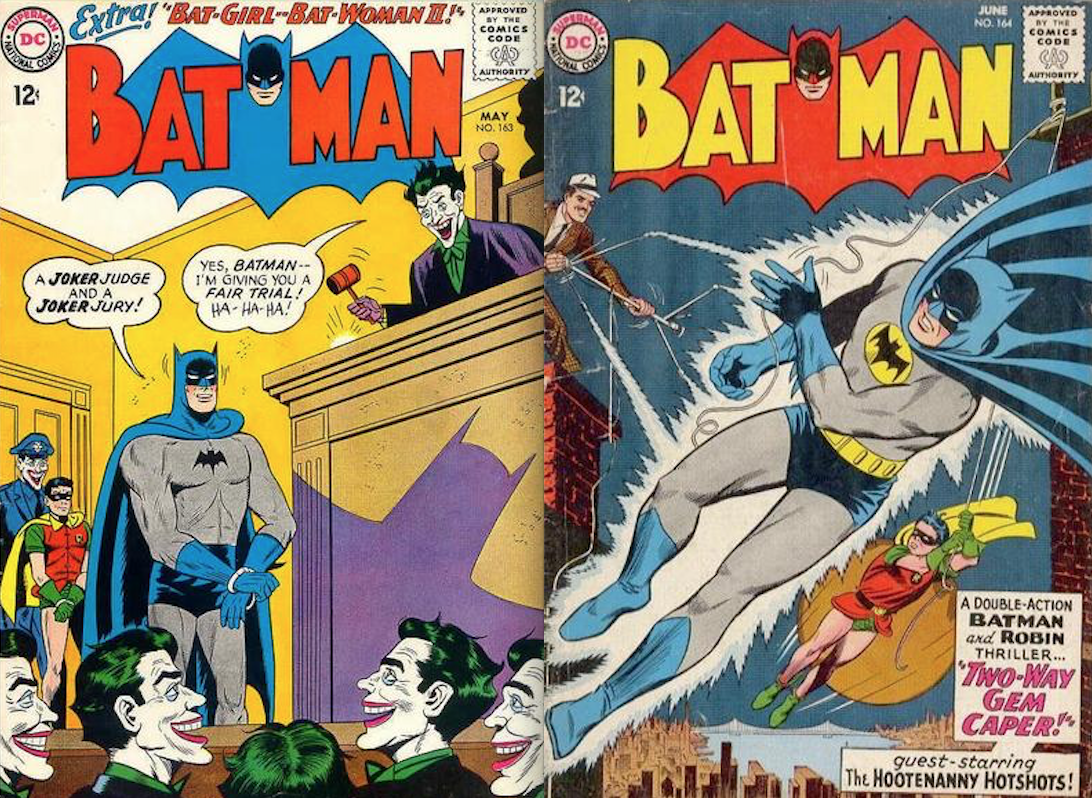
Last “old look” Batman, first “New Look” Batman
I read all these issues many years ago but forgot so many of the details that it seemed like a good thing to do to recharge the batteries. And besides, I figured, maybe I’d get a column idea or two out of it.
So, I’m sitting on the couch the other night and I crack open Batman #167, which was cover-dated Nov. 1964. It’s a full-length story called Zero Hour for Earth!, written by Finger with pencils by Sheldon Moldoff (ghosting for Bob Kane) and inks by Joe Giella.

Carmine Infantino and Murphy Anderson
And right there on the opening splash page, we see Batman’s latest villains — a shadowy international organization called … Hydra.
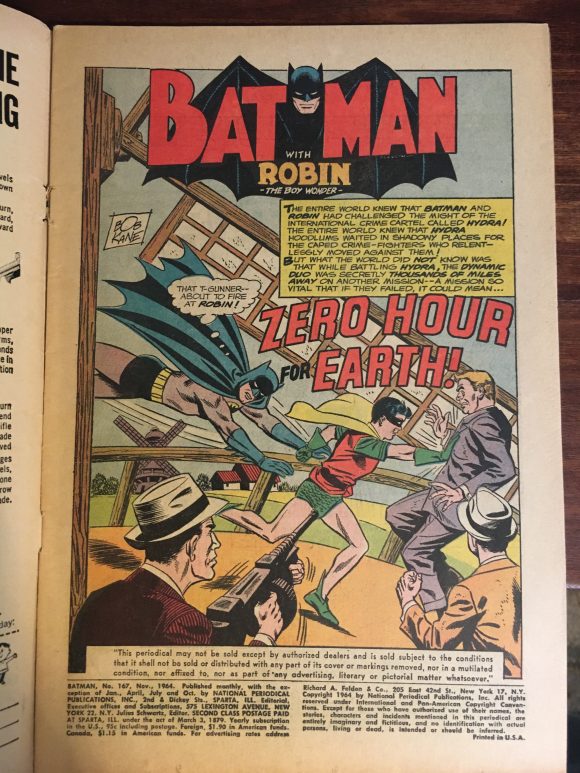
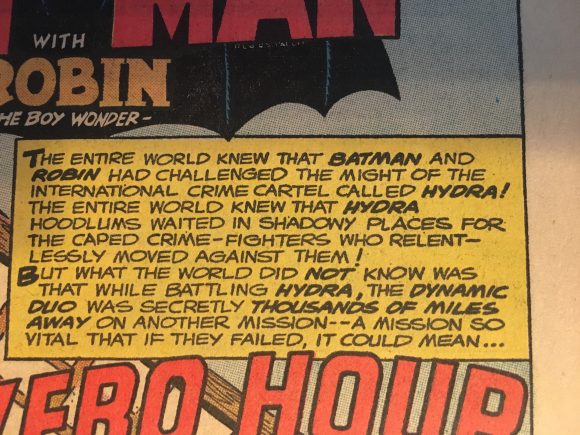
That’s right. Hydra. Less than a year before Stan Lee and Jack Kirby introduced a same-named shadowy international organization in the pages of Strange Tales #135, cover-dated Aug. 1965.
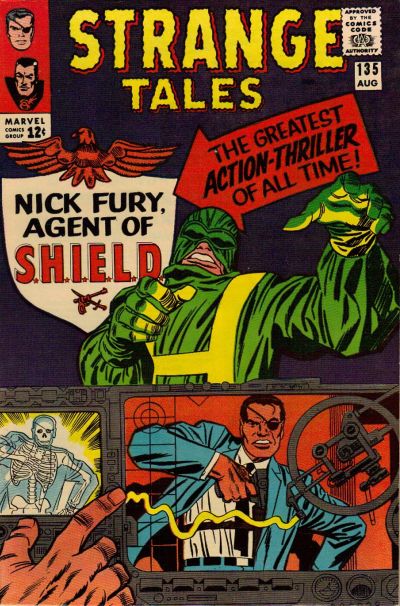
Jack Kirby and Frank Giacoia
Finger’s use of the name is no accident, either. As Commissioner Gordon explains, the organization “calls itself Hydra, after the fabled monster which grew a new head every time one head was lopped off.”
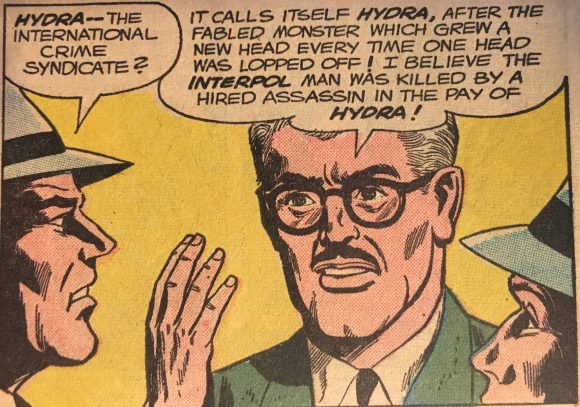
And before you jump in with your correction, reader Edward Pachico pointed out later in Issue #170 that “the hydra grew two heads instead of one.” Editor Schwartz even commended Pachico for being the only reader to catch the mistake.
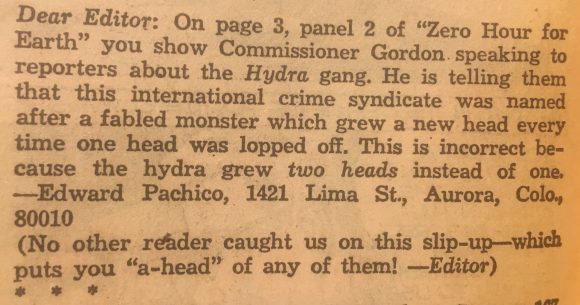
Regardless, the same Bill Finger who built Batman from the ground up from Bob Kane’s original idea — getting jobbed in the process — also created the concept of Marvel’s most nefarious organization, the one at the heart of its movie and TV universes and central to the publisher’s current big summer event.
Bill Finger.
(Oh, and for those keeping Bat-score, Kane’s Batman idea was a guy in a domino mask and red leotard with batwings. Finger gave us a Batman in dark hues, with cape and cowl, wrote the first Batman script in Detective Comics #27 and the scripts for Batman #1. He also had a major hand in creating Robin, the Joker, Penguin, Catwoman, the Riddler, Two-Face, the Scarecrow, the Red Hood, the original Bat-Girl, the Batmobile, the Batcave and the names Bruce Wayne and Gotham City. That’s not even a complete list.)
Now, I have no idea whether Stan Lee and/or Jack Kirby read Batman #167 and the letter that followed and decided to lift the idea. It’s certainly in the realm of possibility. (Any of you readers with intel, please pass it along.) It’s no secret that DC and Marvel paid a lot of attention to each other then as they do now.
Still, as was often the case at the time, Marvel’s braintrust was developing ideas and concepts that were more fully formed and in some very tangible ways more enduring than what DC was producing during that period. So it may be that Marvel’s Hydra sprung coincidentally from the publisher’s extraordinary wellspring of creativity as the company blossomed in the ’60s.
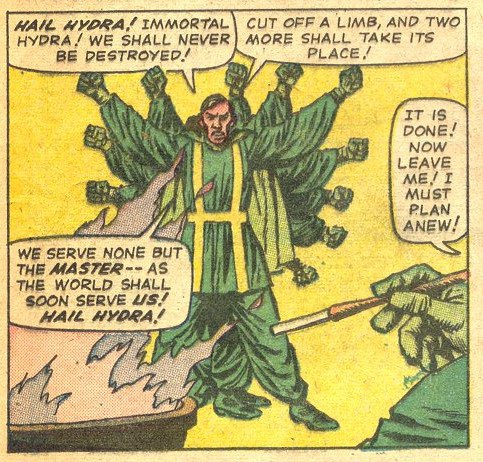
Either way, I have no recollection of Batman ever battling Hydra again, though the end of #167 leaves the door open. (And I’m only up to Batman #171 as I re-read these issues.) It could be that everyone at DC, including Finger, forgot about it as soon as the issue went to press. Or maybe once Marvel went ahead with its version, DC just went its way. Regardless, there’s very little to be found online about this unusual chapter in the Caped Crusader’s history, other than scattered notations here and there.
But it would be unfair to accuse the House of Ideas of stealing one from the Distinguished Competition without acknowledging that Finger and DC were aping James Bond, whose screen adventures were enormously popular at just that moment in pop culture: Batman #167 was hitting the stands just around the time Goldfinger — Sean Connery’s third turn as the world’s greatest spy — was making it to theaters.
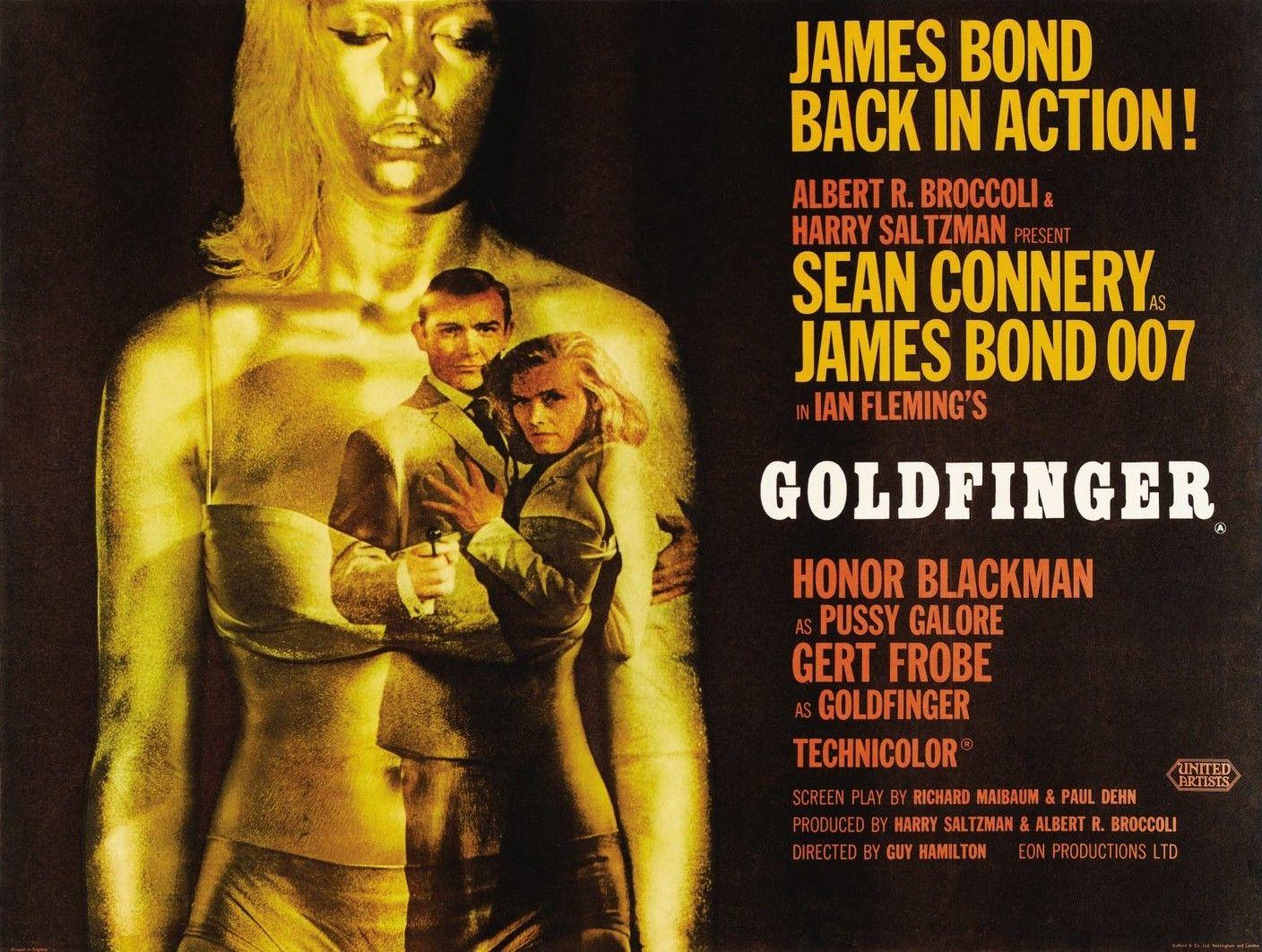
Finger’s version of Hydra may be a criminal gang but it takes its cues from 007’s SPECTRE. There are Hydra heads all over the world and the Dynamic Duo spends the entire issue crisscrossing Europe and Asia more or less playing superhero superspies: They climb the Eiffel Tower, get into a Swiss ski chase and do battle in Holland’s windmills. Bruce even goes undercover in Singapore — white dinner jacket and all — and gets coded information from a comely dancer whose sultry moves mimic semaphore.
It’s crackerjack — if derivative — fun.
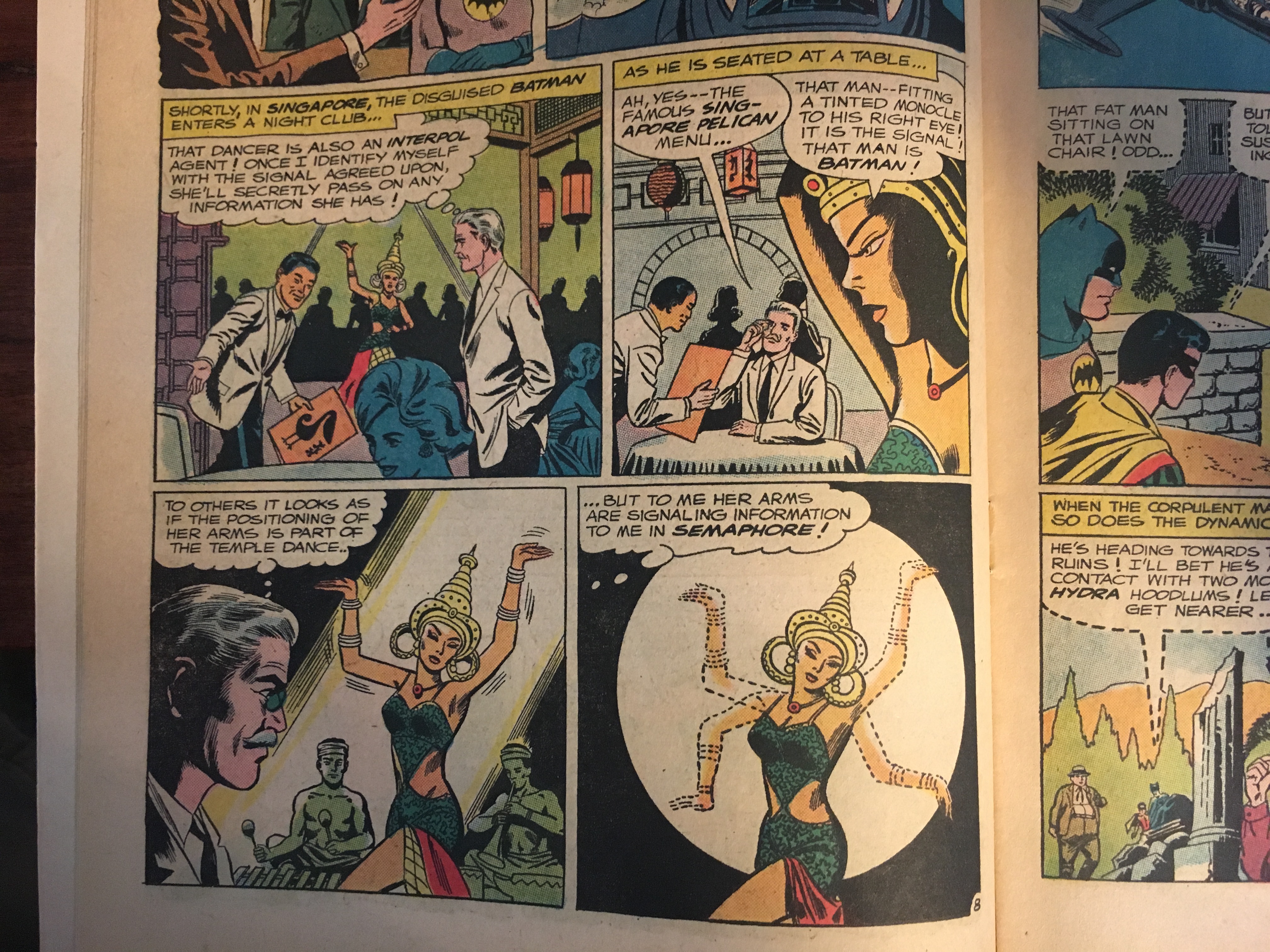
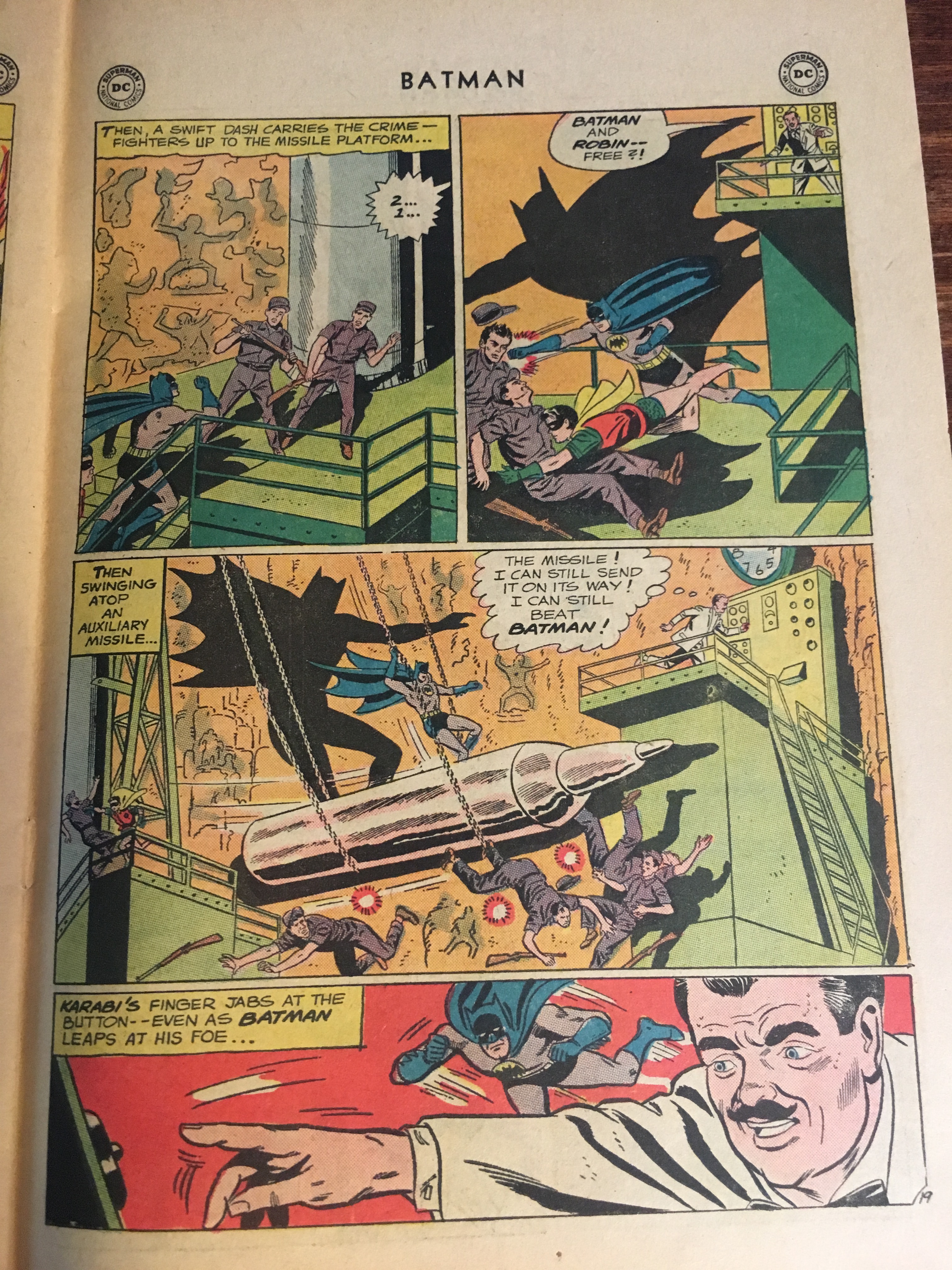
A scene practically ripped from Dr. No.
Of course, less than two years later, Batman would be putting its own colossal stamp on popular culture with the debut of the ABC-TV show in January 1966. The Joker, Riddler, Penguin and Catwoman were introduced or reintroduced to millions of people.
Two generations later, the same would happen to Hydra, thanks to Marvel’s blockbusters.
And now they all have one name in common: Bill Finger.
—
MORE
— A BILL FINGER Tribute: BATMAN From 1939 to Today. Click here.
— Read DC Comics’ Tribute to BILL FINGER. Click here.

August 8, 2017
Finger!
August 8, 2017
What about the criminal organization presented on THE SHADOW pulps? Also it was “a criminal organization that replaces each fallen leader with two new “heads.” Have a look:
https://www.amazon.com/Shadow-No-Murder-Master-Hydra/dp/1932806253
August 10, 2017
Funny, that Shadow book (according to the Amazon blurb) also introduces the world to something borrowed for the Joker’s first caper: telling Gothamites over the radio that he’s going to kill someone!
August 8, 2017
Marvel may well have borrowed the idea of Hydra. The names Daredevil and Captain Marvel, and a team of misfit heroes led by a man in a wheelchair come to mind as other possibilities. I think DC has done the same thing. Batman seems to have been influenced by that bat man pulp magazine character, the Black Bat I think was his name, and Superman owes much to Philip Wylie’s Hugo, Lester Dent’s Doc Savage, and just about everything else Jerry Siegel was a fan of. That just seems to be the way that goes. However, the GLARING omission here, while rightly praising Bill Finger, is not a single mention of Jerry Robinson, truly Batman’s third father. –PL
August 9, 2017
Robinson doesn’t enter into it in this context. But we’re well aware of his contributions: https://13thdimension.com/inside-look-jerry-robinsons-jerry-and-the-joker/
August 9, 2017
I think Jerry Robinson has to enter into it, at least as an important aside, when you mention the creation of the Joker and Robin. You and I and others no doubt know what Robinson contributed to the foundation of the Batman canon but not enough, otherwise that latest credit would read “Batman created by Bob Kane with Bill Finger and Jerry Robinson.” Time to fix that, you have a good vehicle here, why not use it to get a campaign for Jerry going? –PL
August 10, 2017
As has been noted, there is a lot of “borrowing” in pop culture circles. And I don’t mean to take away from Bill Finger’s first use of the Hydra as the name of a criminal enterprise. But on a hunch I looked up the release date of the film “Jason and the Argonauts”, which was my first exposure to the mythological many-headed creature. Sure enough the movie was released in June 1963. The movie was very successful (primarily due to the spectacular special effects by Ray Harryhausen). Also, according to Wikipedia, there was a Dell comic-book adaptation released around that time. Which is all to suggest there may very well be a case of collective sub-conscious influences involved at the very least.
August 13, 2017
Either way…thanks to all for giving the fans great creations, ideas, art, and a great hobby. I’m also going thru my collection and checking out the Batman & Detective runs…great memories to be had.
February 8, 2020
Perhaps you and John S Drew could cover some of the new look issues on the Batcave podcast.
February 8, 2020
Thanks! That time may come, Chris. We’ve got a lot we’re doing now but I could definitely see going down that road…
February 8, 2020
The first 12 cent comic I bought was Batman #174, the Human Punching Bag, in the summer of 65 before the tv show. The death trap and escape would have fit the show easily.